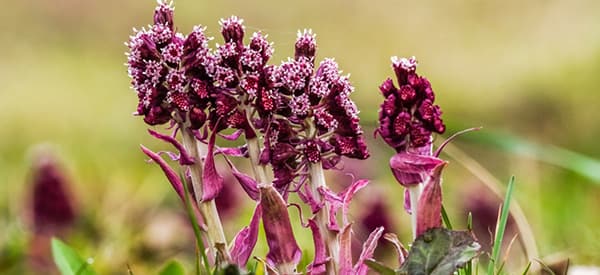
Butterbur
Butterbur (Petasites hybridus) is an herbaceous perennial wildflower thriving in wetlands. It bears distinctive pink tasseled flowers similar to a mushroom. The flowers emerge before the leaves in spring. Butterbur has giant leaves traditionally used to wrap butter in warm weather, which gave the plant its name.
Long ago, common butterbur was used as an herbal treatment for migraine, coughs, and asthma. Today, it is slowly gaining popularity as a dietary supplement with its effectiveness in treating many health concerns. Butterbur is a highly effective cure for allergies, hay fever, and asthma, among others.
Butterbur was used as an herbal remedy for many centuries. It might even date back to the plague in the Middle Ages. It was also dubbed the “plague flower” for its widespread use in treating fever and plague during the Black Death.
Where Is Butterbur Found
Butterbur is native to Asian regions like Korea and China. It is also found in Scandinavia, Southern, and Central Europe, and occasionally in North America. They are abundant in wetlands, lakeshores, riverbanks, meadows, and fields.
How To Identify Butterbur
Butterbur is distinguishable by its large leaves and stocky spikes of flowers. It is sometimes called the “hat plant” because of its giant leaves that can be used as rain protection.
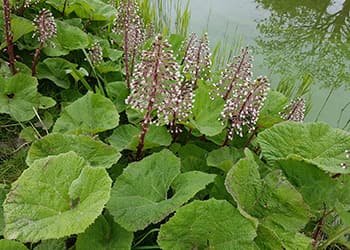 Leaves. The leaves of the butterbur emerge after its flowers, arranged alternately through the flower spike. The flowering stem leaves are stalkless, scale-like, and narrow-tipped. Butterbur’s proper leaves have long stalks with blades shaped like a heart similar to rhubarb. They measure about 20 to 28 inches across and are bluntly serrated. The top portion is smooth while the underside is covered with dense hair.
Leaves. The leaves of the butterbur emerge after its flowers, arranged alternately through the flower spike. The flowering stem leaves are stalkless, scale-like, and narrow-tipped. Butterbur’s proper leaves have long stalks with blades shaped like a heart similar to rhubarb. They measure about 20 to 28 inches across and are bluntly serrated. The top portion is smooth while the underside is covered with dense hair.
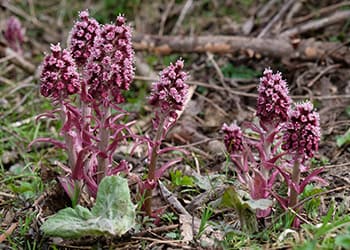 Flowers. Butterbur flowers emerge from the ground like button mushrooms. It has a single flower-like capitulum or flower head densely packed with small florets. The disc florets are reddish and tubular surrounded by modified or specialized leaves with hairy bases. Butterbur is dioecious, which means male and female flowers grow in different plants.
Flowers. Butterbur flowers emerge from the ground like button mushrooms. It has a single flower-like capitulum or flower head densely packed with small florets. The disc florets are reddish and tubular surrounded by modified or specialized leaves with hairy bases. Butterbur is dioecious, which means male and female flowers grow in different plants.
Fruit and Seeds. Butterbur fruits are yellowish-brown achene that does not split open. The seeds are white and flower-like tuft.
Roots. The rhizomatous roots of butterbur are quite vigorous and they can easily overwhelm other plants.
Stem. The hollow, upright and ridged stem of butterbur is circular with lots of small angles. They can grow from 6 to 25 inches, reddish brown to purple in color, and hairy at the top.
⇒ The Complete Map of Edible Plants: Find Out What You Have in Your Area! (Video)
Petasites hybridus is a flowering plant of the Asteraceae, the family of daisies and aster. Its botanical name came from the Greek word petasos.
Its name butterbur was not translated into other languages. However, common butterbur is also referred to as bog rhubarb, Devil’s hat, or pestilence wort.
Petasites hybridus is synonymous with P. officinalis, P. vulgaris and Tussilago hybridus.
Butterbur has other known species like:
- japonicus or Japanese butterbur also known as sweet-coltsfoot or giant butterbur with yellowish flowers
- frigidus or Arctic butterbur, smaller with reddish discs and tongue-like florets
- albus or white-flowered butterbur
- pyrenaicus or P. fragrans or winter heliotrope, with mauve-pink flowers and a light vanilla scent
How To Grow Butterbur
Butterbur is not difficult to grow but the challenge is in keeping them from spreading and colonizing the garden. Growing them in containers or garden barriers tends to eliminate the tediousness of constantly removing them in unwanted areas.
Propagation of butterbur is through its seeds, rhizomes, or softwood cutting. Butterbur seeds are available in some online stores and rare seed collectors.
Growing Butterbur From Seeds
The best time for sowing butterbur is in spring after the danger of the last frost. You can sow the seeds directly in the garden or start them in a potting tray.
Butterbur is easy to germinate as it is a prolific grower when grown in suitable soil conditions. If you choose to plant this herb in your garden, you may need an ample spot for it to spread. Growing them in garden containers is an option, but then it will curb their vigorous rhizomes and may affect the plant’s optimal growth.
⇒ Pressurized Rainwater Harvesting and Purification System (Video)
Start the seeds by pressing them in prepared wet and rich soil. Place the tray in indirect sunlight and keep it moist until germination takes place after about six days.
Transplant the seedlings in the garden when they are sufficiently sized. To cut back on its spreading, line the planting hole with a pool liner or rhizome barrier before transferring the seedlings.
Growing Butterbur From Division
If you want to grow butterbur in your garden, you can also make use of its rhizome. Do this in spring or autumn when the weather is cooler.
Find a healthy butterbur in the wild and dig up the entire plant with a spade. Nicely cut through the roots to divide them, then plant them in holes with a rich soil mixture.
Growing Butterbur From Cuttings
Alternatively, you can also use its softwood cutting and allow it to root in a medium. The substrate is ideally a sterile top layer and coarse bottom layer.
Choose a healthy plant to cut with well-developed young shoots. Separate it into segments so that each segment contains at least one leaf. Plant it in the prepared soil and place the tray in an area with a temperature between 20 to 25⁰C.
After a week, gently tug the cuttings to feel resistance. This indicates that it has rooted successfully. Transfer the new plant to its permanent place and keep the soil moist to encourage its growth.
Plant Care And Maintenance
Butterbur hardly needs attention once it has started to grow. They tend to grow abundantly in the following growing conditions:
- Humus, loamy, and clay soil
- Slightly acidic to neutral soil pH level
- Shade and partial sun
- Moderate to high humidity levels
- Occasional flooding
How To Harvest Butterbur
Harvest the butterbur leaves when they are already developed, sometime in early summer. The roots are ready in late summer or early fall.
Wash the leaves or roots thoroughly and allow them to dry in the shade. Dried butterbur leaves have a green color and are odorless. Meanwhile, the roots are properly dried once it has turned brown, odorless, and with a slightly bitter taste.
⇒ People Weed Out These Plants, But Here’s What You Should Do Instead (Video)
Dried butterbur leaves can last for two years when kept in a dry environment. Its whole rhizomes have a shelf life of about three years.
What Butterbur Is Good For and Natural Remedies Made From It
Butterbur is a widely considered folk medicine for treating symptoms of allergies without unpleasant side effects. It is an effective antihistamine for allergic rhinitis or seasonal allergies. It can relieve symptoms such as sneezing, and itchy and watery eyes. Butterbur is considered the gold standard in herbal remedies for allergies because it does not cause drowsiness, unlike commercial antihistamines.
One of the active main substances of butterbur is petasin. Petasin is antispasmodic and anti-inflammatory. These properties are useful for treating asthma. It suppresses lymphocytes, neutrophils and eosinophils, which helps alleviate bronchial diseases and other problems in the upper respiratory tract. Here’s how to grow a completely natural pharmacy at home.
Butterbur is also a remedy of choice for migraine symptoms like throbbing head pain, light and sound sensitivity, and nausea. As a natural analgesic, it soothes headaches and reduces the severity and duration of migraines.
Externally, butterbur is an excellent herb for wounds, boils, and burns. It is also used in folk remedies for alleviating inflammation due to sprains and dislocations.
Butterbur contains the compound kaempferol, an anti-inflammatory and anti-cancer compound that protects against metabolic diseases. Kaempferol can also prevent oxidative damage to the brain and delay degenerative diseases like Alzheimer’s and dementia.
The antioxidants in butterbur help promote the good overall health of the body, brain, and heart. Its health-promoting compounds reduce the risk of heart disease and manage cholesterol levels. Thus, it prevents susceptibility to heart attack and other cardiovascular problems.
Common butterbur is an antitussive that treats cough, bronchitis, and bronchial asthma. It can also soothe irritated mucous membranes to clear clogged airways and cure other respiratory problems.
⇒ A Simple “At-Home” Protocol for the Flu and Other Respiratory Issues (Video)
In the Middles Ages, butterbur is considered a staple herb for gastrointestinal issues. Its extracts are used to relieve colic, cramps, and even poor bile outflow. Butterbur’s ethanolic extract prevents mucosal damage and ulcer in the intestine brought on by alcohol abuse.
Butterbur contains toxic alkaloids like liver-damaging pyrrolizidine and is still under further study for many other medicinal applications. These alkaloids are often extracted to make butterbur useful for therapeutic uses.
In summary, butterbur is useful for the following purported health concerns: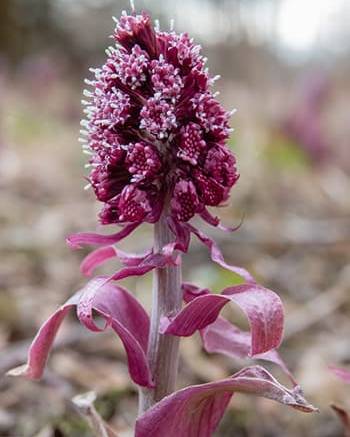
- Seasonal allergies or hay fever
- Asthma, bronchitis, cough, and other respiratory issues
- Gastroenteritis and other gastrointestinal problems
- Migraine
- Brain and mental issues
- Insomnia
- Skin problems
- Peptic ulcer
- Inflammations
- Intestinal parasites
- Cardiovascular problems
- Urinary infections
What Parts Of Butterbur Are Used For Remedies
All parts of the butterbur from its roots, flowering stem, leaves, and flowers are utilized for herbal remedies. It is primarily used as a tea, decoction, or infusion. Crushed butterbur leaves are used as a poultice for sprains and joint dislocations.
Extracts from butterbur leaves are used for treating hay fever, while its root extracts are used for other internal health problems.
Butterbur extracts is an ingredient in some natural supplement like Petadolex for migraine. It is also available in capsule and tablet form sold in some herbal and natural health pharmacies.
A tincture of butterbur is the most effective form as long as its toxic alkaloids are removed.
Butterbur Tea
Ingredients:
- 1 tsp dried butterbur rhizomes
- Water
- Stevia or honey, to taste
Steps:
- Soak the dried butterbur roots in water for about 12 to 20 hours.

- Remove the roots and add them to a pot of fresh water and bring it to a boil. Simmer for 3 to 5 minutes.

- Strain into a cup. Enjoy the cup as it is or add natural sweeteners like stevia, honey or maple syrup according to taste.

How To Use This Remedy
Drink a cup of this soothing tea to manage allergies and other health problems like peptic ulcers and gastritis. Drink it in small sips throughout the day until the symptoms disappear.
The adult dose for butterbur dietary supplement is about 50 to 150 mg daily. It should be used only for a short period to avoid potential liver damage.
What Plants Resemble Butterbur
| Features | Common Butterbur (Petasites hybridus) | Rhubarb (Rheum rhabarbarum) | Coltsfoot (Tussilago farfara) |
|---|---|---|---|
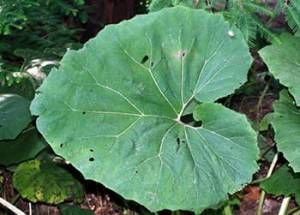 | 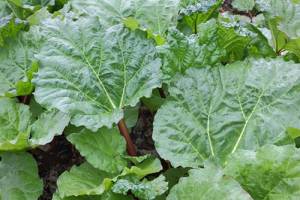 | 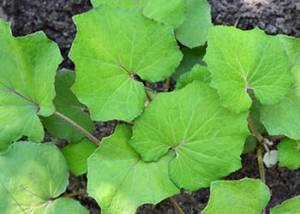 | |
| Size | 6 to 25 inches | 12 to 18 inches | 2 to 12 inches |
| Leaves | Alternate; green; stalkless; heart-shaped; scale-like; narrow-tipped; rhubarb-like; bluntly serrated; dense hair on underside | Dark green/red/ burgundy; large; fleshy; heart-shaped; narrow-tipped | Green; alternate; basal rosette; heart-shaped; slightly serrated; hairy underside |
| Flowers | Purple to reddish: single capitula; small florets; tubular; dioecious; grows before the leaves | Green/white/rose red; branched inflorescence; dense florets; | Yellow; disc-florets surrounded by small florets; appear before the leaves |
| Fruits/Seeds | Yellowish-brown; achene; white pappus | Three-sided achene; winged sides | Brown achene; white fluffy pappus |
| Stem | Hollow; erect; ridged; circular; reddish brown to purple; hairy at nodes | Succulent; hollow; long; thin; deep red to light green | Leafless; wooly hairs; purplish bracts; circular |
| Scent | No discernable scent; foul-smelling rhizomes | Sharp, tart, fruity | Sweet scent |
Warnings And Cautions
Butterbur contains pyrrolizidine alkaloids (PA) that can damage the liver. The safe use of butterbur is through its dietary supplement form where PAs are extracted and the dosage is controlled.
People who are sensitive to plants in the ragweed, daisy, marigold, and chrysanthemums should avoid butterbur. The plant is likely to cause allergic reactions in people with sensitivity to plants related to these families.
Butterbur is not recommended for pregnant and breastfeeding women as its safety is not yet established.
PA-free butterbur is likely safe for children but should be given only upon the advice of a healthcare professional. Children 6 to 17 years old should not take butterbur for more than four months.
Butterbur can interact with other medications especially those used to increase the breakdown of other medications by the liver. Before taking butterbur or any herbal medications, it is best to consult first with a physician. Only a healthcare professional can recommend its dosage and proper use depending on the specific condition, age, and overall health of the patient.
How to Maintain a Healthy, Sharp, and Active Brain While Aging
10 Plants That You Should Never Plant Together (Video)
How to Make a Healing Soap for Eczema and Skin Rashes
10 Beneficial Plants The Government Doesn’t Allow You To Grow






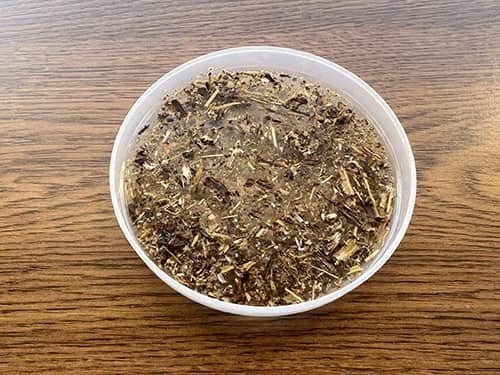
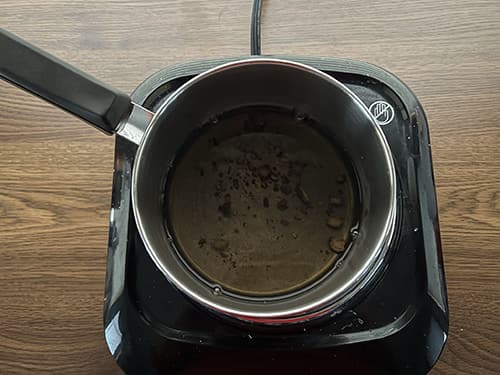
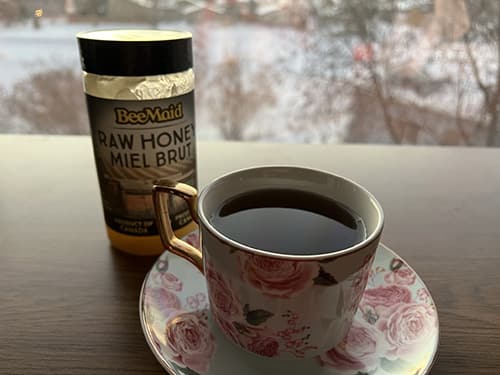

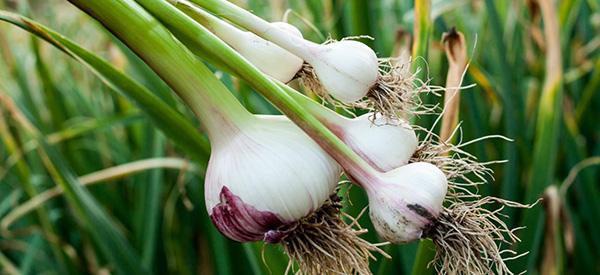
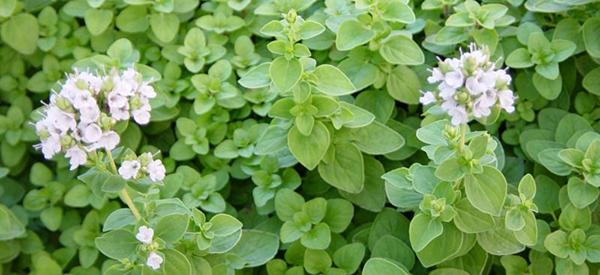
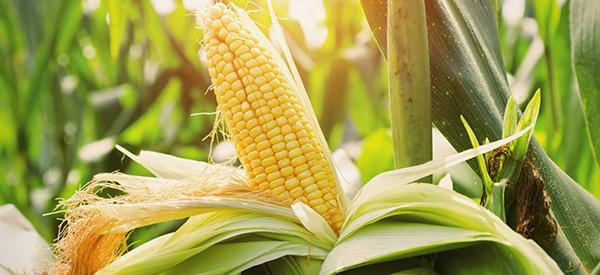
Thank you
Hello Joel,
You’re very welcome.
We’re glad to hear you enjoyed the article.
Many blessings and good health!
How are the alkaloids removed so this herb can be safely used I did not see that info in the above instructions please inform me by email pls as I could really use something like this. Dan. Thanks
Hello Dan,
The most often used product is a standardized extract of Petasites hybridus’ rhizome that has 7.5 mg of petasine per capsule. To prevent liver damage, this kind of extract eliminates the pyrrolizidine alkaloids.
Many blessings and good health!
Does the root soaking for 12-20 hours remove the pyrrolizidine completely? Is that why the roots are soaked?
If so, this should be mentioned in the post